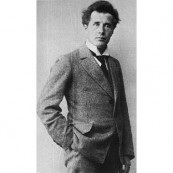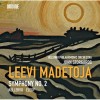Composers
Leevi Antti Madetoja (17 February 1887, Oulu – 6 October 1947, Helsinki)[1] was a Finnish composer.
Born in Oulu, he was the son of Antti Madetoja and Anna Hyttinen. His father emigrated to the United States to earn money for the family, but died of tuberculosis by the Mississippi river, never having seen his son.[2]
Madetoja studied music in Helsinki with Jean Sibelius (1906–1910), Paris with Vincent d'Indy (1910–1911), Vienna and Berlin with Robert Fuchs (1911–1912).[1] In 1913, he married the writer Hilja Onerva Lehtinen (1882–1972)(fi).
His music is strongly influenced by the traditional music of his home region, Ostrobothnia. His three symphonies are based on the legacy of Sibelian and Russian romanticism, Gallic clarity and folk elements.
The sombre Symphony No. 2 was written during the civil war and could be described as a war symphony. Another popular work written in the same year is the elegant piano piece Kuoleman Puutarha (Garden of Death), dedicated to his brother, who had died during the war. His finest works are considered the opera The Ostrobothnians, the Third Symphony, Comedy Overture, the ballet Okon Fuoko, and his songs for male choir. His inspiration slowly dried up, though a fully scored fourth symphony was reportedly lost when his briefcase was stolen at a Paris railway station in 1938. He was planning a violin concerto at the time he died, aged 60, from exhaustion, overwork and heart disease.
Recently Added
| Country: | Finland |
| Period: | Romantique |
Biography
Leevi Antti Madetoja (17 February 1887, Oulu – 6 October 1947, Helsinki)[1] was a Finnish composer.
Born in Oulu, he was the son of Antti Madetoja and Anna Hyttinen. His father emigrated to the United States to earn money for the family, but died of tuberculosis by the Mississippi river, never having seen his son.[2]
Madetoja studied music in Helsinki with Jean Sibelius (1906–1910), Paris with Vincent d'Indy (1910–1911), Vienna and Berlin with Robert Fuchs (1911–1912).[1] In 1913, he married the writer Hilja Onerva Lehtinen (1882–1972)(fi).
His music is strongly influenced by the traditional music of his home region, Ostrobothnia. His three symphonies are based on the legacy of Sibelian and Russian romanticism, Gallic clarity and folk elements.
The sombre Symphony No. 2 was written during the civil war and could be described as a war symphony. Another popular work written in the same year is the elegant piano piece Kuoleman Puutarha (Garden of Death), dedicated to his brother, who had died during the war. His finest works are considered the opera The Ostrobothnians, the Third Symphony, Comedy Overture, the ballet Okon Fuoko, and his songs for male choir. His inspiration slowly dried up, though a fully scored fourth symphony was reportedly lost when his briefcase was stolen at a Paris railway station in 1938. He was planning a violin concerto at the time he died, aged 60, from exhaustion, overwork and heart disease.




